Family Businesses are a core part of economy (Indian as well as global).
Family Business has been defined as a business which is owned and managed (having one or more leadership positions) by family. e.g. A proprietorship where a family member of proprietor is engaged is a family business. A listed company where the family members of promotor / founder are occupying one or more leadership positions (Director, CEO, CFO or any other CXO level position) is a family business.
These businesses faces some peculier risks over and above the risks faces by the other business with the same industry.
In GRC community, some of these risks are labelled as “lack of tone” to “lack of business continuity plan”.
Let’s consider the following table giving best practices for family business and what will happen in case of absence of these good practices:

You can add the following additional risks:
- Intra family Litigation
- Business use and personal use may be mixed (of assets/ expenses)
- Business Seperation
- Divorces
- Vulnerable to fraud due to transaction are based on trusts.
You can have following scenario in a partnership or a company.
Few Individual comes together and start a business. Spouse of a partner/director do not get along with another partner/director. What if that individual happens to die or become incapacitated or divorced?
- Death: Spouse will inherit the partner’s shares
- Incapacitated: Spouse will become trustee of partner’s share
- Divorced: Spouse will get/ attempt to get 50% of partner’s share
Following are some of the risk mitigation strategies to manage these risks (besides the best practices):
- Family Agreement: Family Agreement for owners/ partners to understand their rights, duties & obligations to the business/ each other:
- Rules for managing and controlling the business;
- How distributions will be made to the owners;
- Restrictions on transfer of shares due to divorce or death;
- Buy-sell provisions, succession planning; and
- How dissolution of the business will be handled if the owners can no longer work together.
- Spousal Consent/Waiver Agreements: Ensure Spousal Consent/ Waiver Agreements include all issues:
- Security for all partners so that they do not have to worry about obtaining a spouse’s consent for any business decisions;
- An automatic buy-out mechanism for payment to a partner’s spouse upon that partner’s death in lieu of maintaining an ownership interest (usually done in connection with a buy-sell agreement); and
- Prevents situations in which the other owners are forced to enter into a business relationship with someone they never would have contracted with in the first place.
- Business Succession Plan: Family business owners should consider these issues when creating a business succession plan:
- How will a divorce involving one of the owners impact the
business? - If an owner dies, how will his or her interests be distributed?
- What happens when an owner wants out of the business at some point in the future?
- What options or mechanisms will allow the purchase of a deceased member’s interest without bankrupting the entire business in the process
- How will the fair market value of an owner’s interest be calculated in the event of a buy-out?
- How will a divorce involving one of the owners impact the
Call for action:
Inputs/ comments/ suggestion: I welcome inputs/ comments / suggestions from readers on how to approach this issue. Feel free to correct me, educate me.
Share the Article: If you like it, share it. If you share it with others, and they comment, we all will get more learned.
(Disclaimer: The views expressed constitute the opinion of the author and the author alone; they do not represent the views and opinions of the author ’s employers, supervisors, nor do they represent the view of organizations, businesses or institutions the author is, or has been a part of.)
Reference:
